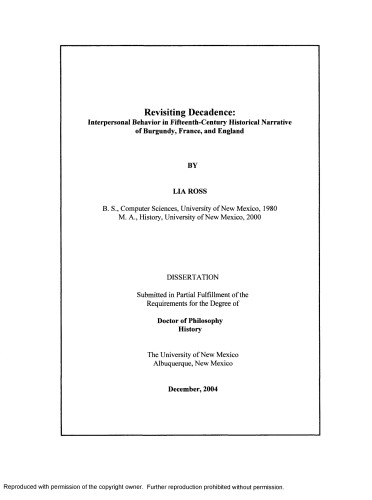Product desciption
Revisiting Decadence Interpersonal Behavior In Fifteenthcentury Historical Narrative Of Burgundy France And England Lia Ross by Lia Ross instant download after payment.
This dissertation discusses the concept of late medieval decadence, introduced by Johan Huizinga in his classic study of thought and culture in northern Europe in the fourteenth and fifteenth centuries. It examines decadence as expressed through interpersonal behavior, in particular social interaction between equals, superiors and inferiors in fifteenth-century Burgundy, northern France, and England. In so doing, it expands the geographical area covered by the Dutch author, while confining its time period to one century. Its methodology is to analyze how this subject was treated in contemporary historical narrative (chronicles, memoirs, and diaries) within situations that were most relevant to those sources, intersecting with themes traditionally associated with late medieval decadence. It departs, therefore, from Huizinga's approach of examining late medieval thought mainly through works of art and literature (with historical works serving an ancillary function), focusing instead on the narrative of actions, reactions, and motives of real contemporary figures. It also departs from traditional approaches through the use of social psychology and sociology, relying on modern works in these two disciplines, in addition to those of historical criticism, as aids both in its thematic selections and its conclusions.
In it, the concept of fifteenth-century decadence finds expression through a variety of broad themes. Within the theater of war (the single most prolific subject in contemporary chronicles, and one that still colors negatively our perception of this era), this work identifies various styles of leadership and their relative success with subordinates and civilians. Then it examines tournaments and other staged performances, a thematic group dear to some chroniclers, for their relevance to the ever-present issue of how displays of violence may or may not influence violent behavior in society. In its central chapter it discusses the intrigues of the nobility revolving around feeble or mad kings, and their legacy of conflicts in this century known for its “over-mighty subjects,” in the light of psychosocial interpretations of depression and of various aspects of manipulative behavior. Another central theme to contemporary history, the frequent but ultimately unsuccessful urban revolts, becomes the subject of an analysis of behavioral characteristics of various urban populations vis-à-vis their rulers. The work concludes with a discussion of the collective obsession with death, allegedly peculiar of this period. For this purpose it contrasts the viewpoint of historical narrative, with its descriptions of infliction and suffering of death, with conclusions resting on other types of sources.
This work ultimately provides a new interpretation of fifteenth-century decadence through an examination of how fifteenth century historians, chroniclers, and diarists presented their actors, interpreted personalities and motives, and defined acceptable and unacceptable behavior.


